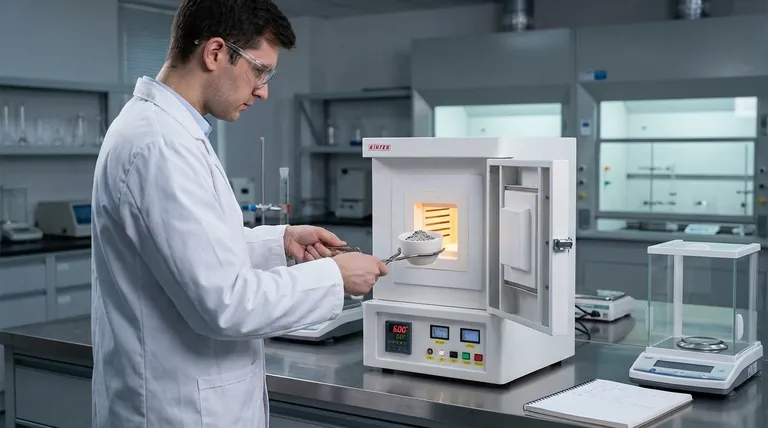The fundamental point of ashing is to systematically burn away all organic, combustible material from a sample in order to isolate and analyze the inorganic, non-combustible residue that remains. This process of purification by high-temperature combustion allows for the precise measurement of a substance's mineral or elemental content, which is a critical metric in many scientific and industrial fields.
Ashing is not about destroying a sample; it's about revealing its inorganic foundation. By completely removing the organic "noise," you can accurately quantify the mineral content, a key indicator of quality, purity, and nutritional value.

The Core Principle: Analysis Through Removal
Ashing is a foundational technique in analytical chemistry that determines a material's composition by first removing a major portion of it.
Burning Off the Organics
The process involves placing a carefully weighed sample into a specialized, high-temperature ashing furnace. The furnace heats the sample in the presence of abundant air, causing all organic compounds (those based on carbon) to react with oxygen and completely combust.
What Remains is the Ash
After combustion, the only material left is the ash. This residue consists entirely of the inorganic, non-combustible compounds from the original sample, such as minerals, salts, and metallic oxides.
Quantifying the Result
By weighing the ash and comparing it to the original sample weight, analysts can calculate the percentage of inorganic material. This simple but powerful data point serves as a crucial quality metric.
Why This Measurement is Critical
The total ash content provides essential information across a wide range of applications, from ensuring food safety to validating industrial materials.
Nutritional Analysis in Food Science
In the food industry, ashing is the standard method for determining the total mineral content of a product. This value is essential for accurate nutritional labeling, verifying the presence of vital minerals like calcium, iron, and potassium.
Quality Control for Materials
For industries like petrochemicals and polymers, the amount of inorganic material can indicate the presence of fillers, catalysts, or contaminants. Ash testing is a critical quality control parameter to ensure products meet strict compliance and performance standards.
Preparing for Elemental Analysis
Often, ashing is just the first step. Once the organic matrix is removed, the isolated ash can be subjected to further, more advanced analysis to identify and quantify the specific elements and minerals it contains.
Common Pitfalls and Considerations
While the concept is straightforward, achieving accurate and repeatable results requires careful control over the process.
Incomplete Combustion
If the temperature is too low or the time is too short, some organic material may fail to combust, a process known as charring. This results in an artificially high ash weight and an inaccurate reading. Modern ashing furnaces are designed with high airflow to prevent this.
Volatilization of Minerals
Conversely, if the temperature is too high, some minerals and metallic salts can become volatile and escape as vapor. This leads to a loss of material and an artificially low ash weight, skewing the final analysis.
Atmospheric Control
For certain sensitive analyses, the sample may need to be ashed in a specific atmosphere (e.g., without oxygen). This requires a more complex closed-system furnace to prevent unwanted chemical reactions during heating.
Making the Right Choice for Your Goal
The application of ashing is defined by the information you need to extract from your sample.
- If your primary focus is nutritional labeling: Ashing is the definitive method for determining the total mineral content to be listed on a product's nutrition facts panel.
- If your primary focus is material quality control: Use ashing to quickly verify the percentage of inorganic filler or impurities in polymers, fuels, or other manufactured goods.
- If your primary focus is elemental research: Ashing serves as the essential first step to purify a sample, removing the organic interference before conducting more sensitive elemental analysis.
Ultimately, ashing provides a clear and quantitative window into the non-organic foundation of a material.
Summary Table:
| Aspect | Purpose of Ashing |
|---|---|
| Core Principle | Burn away organic material to isolate inorganic residue (ash). |
| Primary Goal | Precisely quantify the mineral or inorganic content of a sample. |
| Key Applications | Nutritional analysis (food science), quality control (materials), sample preparation for elemental analysis. |
| Critical Factor | Controlled high-temperature combustion to ensure complete burning without mineral loss. |
Ready to achieve precise and reliable ashing results in your lab?
KINTEK specializes in high-quality lab equipment, including robust ashing furnaces designed for accurate temperature control and optimal airflow to prevent incomplete combustion or mineral loss. Whether you're working in food science, materials testing, or advanced research, our solutions help you extract critical inorganic data with confidence.
Contact us today via our [#ContactForm] to discuss your specific application and discover how KINTEK can support your laboratory's needs for purity and precision.
Visual Guide

Related Products
- 1700℃ Muffle Oven Furnace for Laboratory
- 1800℃ Muffle Oven Furnace for Laboratory
- 1400℃ Muffle Oven Furnace for Laboratory
- High Temperature Muffle Oven Furnace for Laboratory Debinding and Pre Sintering
- Laboratory Muffle Oven Furnace Bottom Lifting Muffle Furnace
People Also Ask
- What is the difference between a crucible and a furnace? Understanding the Heat Source and Container Partnership
- What is the debinding process? A Guide to Critical Binder Removal for MIM & 3D Printing
- Why do we need to use properly some of the laboratory apparatus in the laboratory? The Foundation of Safe and Accurate Science
- What hazard is involved when using a furnace? Protect Your Home from the Silent Killer
- What affects the melting point of a substance? Uncover the Key Factors & Forces



















